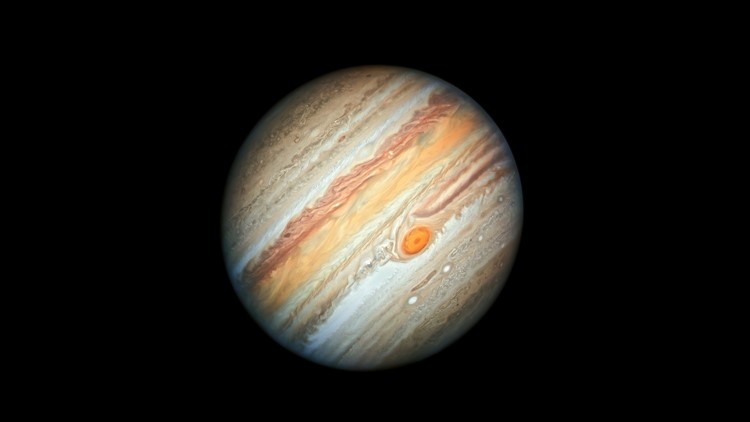The Great Red Spot is Jupiter’s most defining feature, and researchers say the storm has been shrinking for the last 150 years. Last year, photos taken by NASA’s Juno mission appeared to show the Great Red Spot shedding flakes, as though it was dying.
But Philip Marcus, a computational physicist at the University of California, Berkeley, doesn’t think the flakes are the spot’s death knell. He and his team of students shared their findings during the American Physical Society’s Division of Fluid Dynamics 72nd Annual Meeting in Seattle on Monday.
Some believe the giant storm, called an anticyclone because it moves in the opposite direction of the planet’s orbit, was first seen in 1664 by Robert Hooke — although it’s argued that Hooke was looking at a different storm on Jupiter. NASA says the first confirmed sighting was in 1831.
Since then, the storm has been tracked and analyzed each year since 1878, accounting for size, color, drift rate and shape.
Currently, the Great Red Spot’s diameter could hold two Earth-sized planets. The storm itself is structured like a wedding cake, with an upper layer extending more than three miles higher than its surrounding clouds, according to NASA.
Marcus and his team conducted a computer analysis of detailed, high-resolution images of the Great Red Spot and determined that the size of the underlying vortex doesn’t necessarily equal the clouds that we can see. They tested another storm on Jupiter and found the same thing, suggesting that the shrinking of the clouds doesn’t have anything to do with the vortex of the storm itself.
“I don’t think its fortunes were ever bad,” Marcus said of the Great Red Spot. “It’s more like Mark Twain’s comment: The reports about its death have been greatly exaggerated.”
Anticyclones are visibly defined on Jupiter, whereas actual cyclones may only appear via wispy clouds, or not at all.
When cyclones and anticyclones interact, they repel each other, which allows scientists to infer the existence of an unseen cyclone just by interacting with an anticyclone, Marcus said.
Anticyclones actually attract each other, and are known to merge or gobble each other up. But much like a snake swallowing its prey, when one anticyclone merges with another one it doesn’t digest it immediately. Instead, the smaller anticyclone appears like a lump traveling around the outer band of the larger one.
In the Juno images analyzed by amateur astronomers last year, Marcus argues that what they were actually seeing were undigested lumps traveling counterclockwise along the boundary of the Great Red Spot.
Around the same time, the anticyclone encountered a cyclone and the lump was detached, shearing off in a shape that resembled a blade.
Encountering cyclones creates a stagnation point where velocity comes screeching to a halt before restarting and moving in a different direction — causing clouds to shatter and resemble “flakes” like the ones that appeared to be shedding from the Great Red Spot.
“The loss of undigested clouds from the [Great Red Spot] through encounters with stagnation points does not signify the demise of the GRS,” he said. “The proximity of the stagnation points to the GRS during May and June does not signify its demise. The creation of little vortices to the east, northeast of the GRS during the spring of 2019 and their subsequent merging with the GRS does not signify its demise.”
The Great Red Spot essentially persists because of a cool region above it and a warm region below it that act as stabilizers, Marcus said.
More lumps and flakes will likely be visible in the future because the Great Red Spot will continue to encounter other anticyclones about every few months.
“Unless something cataclysmic happens, the Great Red Spot will last for the indefinite future, likely centuries,” Marcus said. He said the exception could be if Jupiter’s jetstreams reverse.
And he agreed with studies that say the area is changing, or suggest that it could be shrinking — at least, as far as the clouds go. “The size of cloud doesn’t reveal the size of the engine beneath it,” Marcus said, referring to the actual vortex. “And becoming rounder is a sign of a stronger vortex, not a dying one.”



